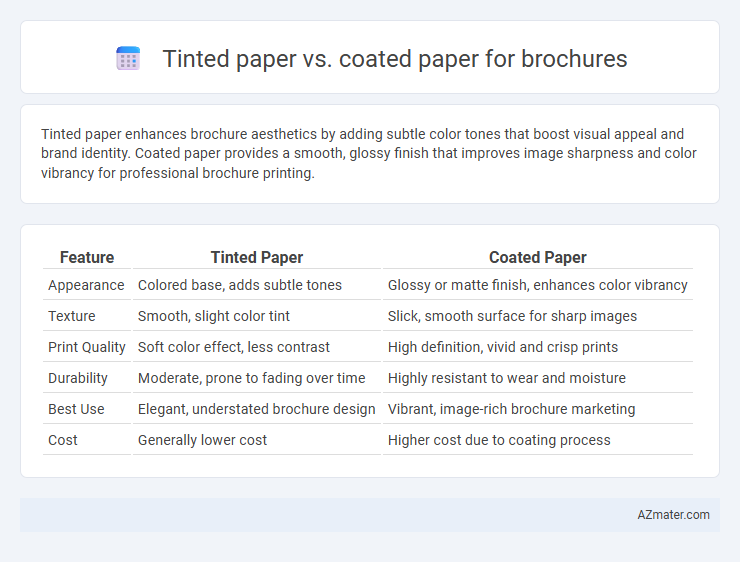Tinted paper enhances brochure aesthetics by adding subtle color tones that boost visual appeal and brand identity. Coated paper provides a smooth, glossy finish that improves image sharpness and color vibrancy for professional brochure printing.
Table of Comparison
| Feature | Tinted Paper | Coated Paper |
|---|---|---|
| Appearance | Colored base, adds subtle tones | Glossy or matte finish, enhances color vibrancy |
| Texture | Smooth, slight color tint | Slick, smooth surface for sharp images |
| Print Quality | Soft color effect, less contrast | High definition, vivid and crisp prints |
| Durability | Moderate, prone to fading over time | Highly resistant to wear and moisture |
| Best Use | Elegant, understated brochure design | Vibrant, image-rich brochure marketing |
| Cost | Generally lower cost | Higher cost due to coating process |
Introduction: Understanding Brochure Paper Types
Tinted paper for brochures offers a subtle background color that enhances design aesthetics and improves readability, making it ideal for creative or themed marketing materials. Coated paper, with its glossy or matte finish, provides a smooth surface that intensifies color vibrancy and sharpness, commonly used for high-quality, professional brochures. Both paper types impact the brochure's tactile feel and visual appeal, influencing customer perception and engagement.
What is Tinted Paper?
Tinted paper is paper manufactured with color throughout the entire sheet, offering a consistent hue without the need for additional inks or dyes on the surface. It provides a subtle background tone that enhances the visual appeal and readability of brochures, especially when contrasted with text and images. Unlike coated paper, which has a glossy or matte finish applied on the surface to improve print sharpness, tinted paper relies on its inherent color to create mood and style while maintaining a natural texture.
What is Coated Paper?
Coated paper features a surface layer of clay or polymer that enhances brightness, smoothness, and ink holdout, making it ideal for high-quality brochure printing with sharp images and vibrant colors. This paper type reduces ink absorption, resulting in crisp text and detailed graphics, which ensures professional presentation and durability. Compared to tinted paper, coated paper offers superior print performance and is preferred for brochures requiring vivid visuals and a polished finish.
Visual Appeal: Color and Finish Comparison
Tinted paper offers a unique color base that enhances brochure design by adding subtle hues, creating depth and mood without relying heavily on printed inks. Coated paper features a glossy or matte finish that boosts color vibrancy and sharpness, making images and graphics appear more striking and polished. Choosing tinted paper emphasizes a distinctive tactile feel with muted tones, while coated paper delivers high contrast and brightness for visually impactful marketing materials.
Print Quality: Ink Absorption and Sharpness
Tinted paper offers moderate ink absorption, which can slightly dull colors but enhances contrast for specific designs, making it ideal for artistic brochures. Coated paper features a smooth, non-porous surface that prevents excessive ink absorption, resulting in vibrant colors and sharp, detailed images that elevate print quality. For sharpness and vividness in brochures, coated paper outperforms tinted paper by delivering crisper text and more precise graphics.
Durability and Feel: Texture Matters
Tinted paper offers a unique tactile experience with its smooth yet subtly textured surface, enhancing the brochure's visual appeal while providing moderate durability suitable for short-term use. Coated paper, coated with a glossy or matte finish, delivers superior durability resisting wear, moisture, and fading, making it ideal for brochures intended for frequent handling and long-term use. The choice between tinted and coated paper directly impacts the brochure's feel and longevity, with coated paper generally preferred for its robust protection and polished texture.
Cost Considerations: Price Differences
Tinted paper generally costs less than coated paper due to lower manufacturing complexity and reduced processing requirements. Coated paper, with its glossy or matte finish, involves additional coating materials and treatments, increasing production expenses and final price. For brochures, choosing tinted paper can be more budget-friendly while coated paper offers premium appearance at a higher cost.
Eco-Friendliness: Sustainability Factors
Tinted paper for brochures often utilizes natural dyes and minimal processing, making it a more sustainable choice compared to coated paper, which typically involves chemical treatments and plastic-based coatings that hinder recyclability. The eco-friendliness of tinted paper stems from its biodegradability and reduced energy consumption during production, contributing to lower carbon emissions. In contrast, coated paper's glossy finish can interfere with composting and recycling processes, making tinted paper the preferable option for environmentally conscious marketing materials.
Ideal Use Cases for Tinted vs. Coated Paper
Tinted paper is ideal for brochures aiming to evoke a vintage or artistic feel, often used in luxury branding, invitations, and eco-friendly product promotions where subtle color tones enhance the design. Coated paper, with its smooth, glossy or matte finish, excels in high-resolution image reproduction, making it perfect for vibrant, photo-centric brochures in industries like real estate, travel, and retail. Choosing tinted paper suits projects emphasizing texture and tone, while coated paper is best for sharp visuals and color contrast.
Conclusion: Choosing the Best Paper for Your Brochure
Selecting the ideal paper for your brochure hinges on your brand's aesthetic and messaging goals; tinted paper offers a unique, subtle color base that enhances visual appeal for creative and artistic themes, while coated paper provides a smooth, glossy finish that sharpens images and text for a polished, professional look. For high-impact visuals and vibrant color reproduction, coated paper is preferred due to its superior ink hold and clarity. Tinted paper suits brochures aiming for a distinctive, textured feel that stands out in tactile marketing materials.

Infographic: Tinted paper vs Coated paper for Brochure
 azmater.com
azmater.com